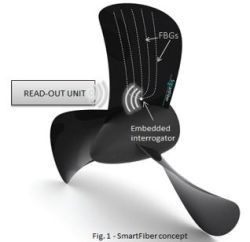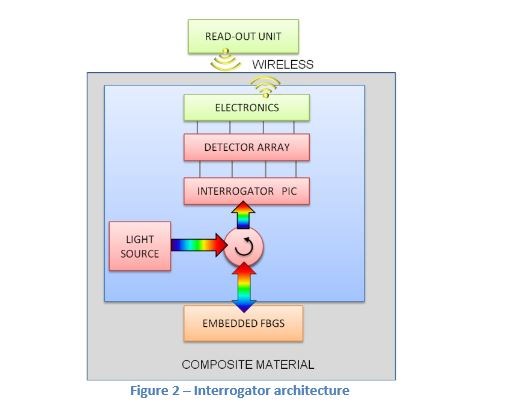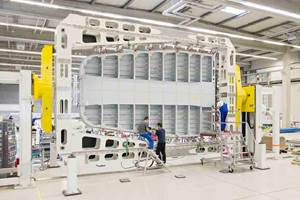Mini fiber-optic SHM system embedded into composites
Partners in the SMARTFIBER project have demonstrated continued and automatic structural health monitoring.

SMARTFIBER concept of SHM system using Fiber Bragg Grating sensors embedded into a composite tidal turbine blade. SOURCE: SMARTFIBER project.
Structural health monitoring (SHM) is an emerging widespread discipline in a variety of structures, including steel and concrete bridges and buildings. In composites, SHM has been pursued for decades with several goals:
-
Prevent failures from overload, manufacturing defect or damage;
-
Reduce the frequency and cost of inspection during service;
-
Provide real-time understanding of the fracture mechanics in composites and validation data for existing finite element models with a view also toward increasingly complex designs.
SMARTFIBER is a 42-month project (Sept 2010 to April 2014) funded by the European Union Seventh Framework Programme with the goal of embedding a miniaturized complete sensor system — including both sensor array and autonomous readout unit, or interrogator — into a composite structure, in this case, a tidal turbine. The seven partners claim they have demonstrated the world’s first miniaturized fiber-optical sensor system than can be fully embedded in a composite material. They assert that this achievement paves the way toward smart composites that enable continued and automatic monitoring of the structural health of composite material in structures such as tidal blades, wind turbine blades, airplane fuselage and wing components or marine structures (masts, antennas, hulls and propellers).
The SMARTFIBER partners include:
- Nanoelectronics research center IMEC (Leuven, Belgium)
- Ghent University (Gent, Belgium)
- Optocap Ltd (Livingtson, West Lothian, U.K.)
- Xenics (Leuven, Belgium)
- Fraunhofer Institute for Integrated Circuits IIS (Erlangen, Germany)
- FBGS International (Geel, Belgium)
- Airborne International (The Hague, The Netherlands).
As can be seen in Fig. 1 above from the project’s final white paper, the SMARTFIBER approach consists of embedding a system of Fiber Bragg Grating (FBG) sensors and low-cost, miniaturized interrogator into the composite structure, enabling wireless power and two-way communication with an external read-out unit (see Figure 2 below). Automated (vs. manual) placement of the sensors and interrogator unit during structure manufacturing was also demonstrated.

The key to the SMARTFIBER SHM system is a low-cost, miniaturized interrogator for the FBG sensors, embedded into the composite structure and enabling wireless power as well as two-way communication with an external read-out unit. SOURCE: SMARTFIBER
FBG sensors were used due to their ability to provide continuous monitoring coupled with their compactness, lightweight, immunity to electromagnetic interferences (EMI), high resistance to corrosion, high temperature capacity and multiplexing capabilities. The team believed them superior over other strain monitoring techniques (e.g. classical electrical strain gauges) especially when pursuing automated embedding during manufacture.
Silicon photonics technology enabled the high miniaturization and low cost sought for the FBG interrogator. The core of the interrogator is a photonic integrated circuit (PIC) that transmits a signal which, after being processed, is received by the external read-out unit. The latter also supplies wireless power to the interrogator. Another key component of the interrogator is a tailored Array Waveguide Grating (AWG) filter. The SMARTFIBER paper asserts that all of these devices can be manufactured using well-established industrial silicon-based microfabrication techniques and infrastructure.
The sensor system was assembled by Optocap on an electronic board designed by Xenics. The optical subsystem consisted of a silicon photonics integrated circuit developed by IMEC and photodiodes and read-out integrated circuits (ICs) provided by Xenics.
Fraunhofer Institute for Integrated Circuits IIS was responsible for the wireless interface which provides power to the embedded system and at the same time reads out the acquired data at high speed.
After being connected to an optical fiber sensor chain manufactured by FBGS International, the sensor system was cast into an epoxy shape specifically designed by Ghent University to minimize the impact on the composite material. Together with the attached fiber sensor chain, the sensor system was then embedded into the blade of a tidal turbine by Airborne International, which also conducted studies into automation of this process during blade fabrication.
The complete system was integrated within the tidal turbine blade, a sandwich construction with a foam core and non-crimp fabric faceskins. Light resin transfer molding (LRTM) was used to mold the blade. Extra layers of glass fabric were placed to minimize resin build-up around the embedded system and to reduce the abrupt change in stiffness from laminate to embedded elements. The optical fiber was placed along the longitudinal length of the blade in loops from tip to root and held in position by small dots of glue. A strategy for automated placement was also developed.
The embedded system was tested and compared to a commercial interrogator. Its performance was on target with the project goals. “We are investigating steps to be taken towards commercialization of the device,” says project leader Dries Van Thourhout, “Input from potential partners is welcome.”
Related Content
Bladder-assisted compression molding derivative produces complex, autoclave-quality automotive parts
HP Composites’ AirPower technology enables high-rate CFRP roof production with 50% energy savings for the Maserati MC20.
Read MoreFrom the CW Archives: Airbus A400M cargo door
The inaugural CW From the Archives revisits Sara Black’s 2007 story on out-of-autoclave infusion used to fabricate the massive composite upper cargo door for the Airbus A400M military airlifter.
Read MoreGKN Aerospace, Joby Aviation sign aerostructures agreement
GKN Aerospace will manufacture thermoplastic composite flight control surfaces for Joby’s all-electric, four-passenger, composites-intensive ride-sharing aircraft.
Read MoreComposite resins price change report
CW’s running summary of resin price change announcements from major material suppliers that serve the composites manufacturing industry.
Read MoreRead Next
VIDEO: High-volume processing for fiberglass components
Cannon Ergos, a company specializing in high-ton presses and equipment for composites fabrication and plastics processing, displayed automotive and industrial components at CAMX 2024.
Read More“Structured air” TPS safeguards composite structures
Powered by an 85% air/15% pure polyimide aerogel, Blueshift’s novel material system protects structures during transient thermal events from -200°C to beyond 2400°C for rockets, battery boxes and more.
Read MoreAll-recycled, needle-punched nonwoven CFRP slashes carbon footprint of Formula 2 seat
Dallara and Tenowo collaborate to produce a race-ready Formula 2 seat using recycled carbon fiber, reducing CO2 emissions by 97.5% compared to virgin materials.
Read More




















